
An interceptor aircraft, or simply interceptor, is a type of fighter aircraft designed specifically for the defensive interception role against an attacking enemy aircraft, particularly bombers and reconnaissance aircraft. Aircraft that are capable of being or are employed as both ‘standard’ air superiority fighters and as interceptors are sometimes known as fighter-interceptors. There are two general classes of interceptor: light fighters, designed for high performance over short range; and heavy fighters, which are intended to operate over longer ranges, in contested airspace and adverse meteorological conditions. While the second type was exemplified historically by specialized night fighter and all-weather interceptor designs, the integration of mid-air refueling, satellite navigation, on-board radar and beyond visual range (BVR) missile systems since the 1960s has allowed most frontline fighter designs to fill the roles once reserved for specialised night/all-weather fighters.

The Mikoyan MiG-31 is a supersonic interceptor aircraft that was developed for use by the Soviet Air Forces. The aircraft was designed by the Mikoyan design bureau as a replacement for the earlier MiG-25 "Foxbat"; the MiG-31 is based on and shares design elements with the MiG-25. The MiG-31 is among the fastest combat jets in the world. It continues to be operated by the Russian Air Force and the Kazakh Air Force following the end of the Cold War and the collapse of the Soviet Union in 1991. The Russian Defence Ministry expects the MiG-31 to remain in service until 2030 or beyond; that was confirmed in 2020 when an announcement was made to extend the service lifetime from 2,500 to 3,500 hours on the existing airframes.
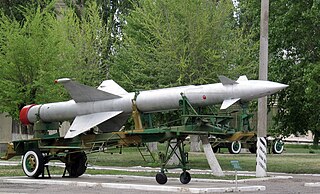
The S-25 Berkut is a surface-to-air guided missile, the first operational SAM system in the Soviet Union. In the early 1950s it was tested at Kapustin Yar. It was deployed in several rings around Moscow starting in 1955 and became combat ready in June 1956. It was used only defensively at Moscow; the more mobile S-75 would be used in almost all other locations. Several improvements were introduced over its long service lifetime, and the system was finally replaced by the S-300P in 1982.
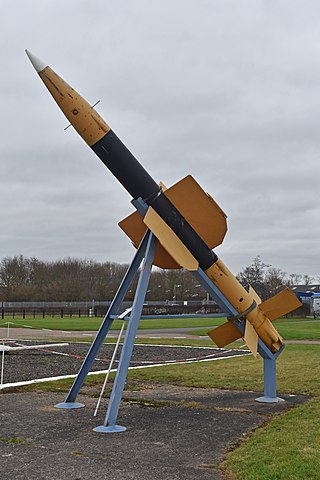
Seaslug was a first-generation surface-to-air missile designed by Armstrong Whitworth for use by the Royal Navy. Tracing its history as far back as 1943's LOPGAP design, it came into operational service in 1961 and was still in use at the time of the Falklands War in 1982.
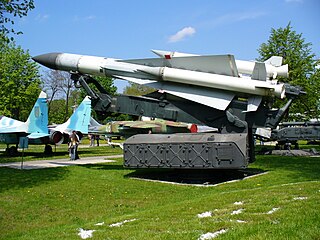
The NPO Almaz S 200 Angara/Vega/Dubna, NATO reporting name SA-5 Gammon, is a long range, high altitude surface-to-air missile (SAM) system developed by the Soviet Union in the 1960s to defend large areas from high-altitude bombers or other targets. In Soviet service, these systems were deployed primarily on the battalion level, with six launchers and a fire control radar.

The Raytheon MIM-23 HAWK is an American medium-range surface-to-air missile. It was designed to be a much more mobile counterpart to the MIM-14 Nike Hercules, trading off range and altitude capability for a much smaller size and weight. Its low-level performance was greatly improved over Nike through the adoption of new radars and a continuous wave semi-active radar homing guidance system. It entered service with the US Army in 1959.

The BQM-74 Chukar is a series of aerial target drones produced by Northrop. The Chukar has gone through three major revisions, including the initial MQM-74A Chukar I, the MQM-74C Chukar II, and the BQM-74C Chukar III. They are recoverable, remote controlled, subsonic aerial target, capable of speeds up to Mach 0.86 and altitudes from 30 to 40,000 ft.
The Hsiung Feng IIE is a surface-to-surface cruise missile system developed by the National Chung-Shan Institute of Science and Technology (NCSIST) in Taiwan.

The Lockheed DC-130 was a variant of the C-130 Hercules, designed for drone control. It could carry four Ryan Firebee drones underneath its wings.

The Ryan Model 147 Lightning Bug is a jet-powered drone, or unmanned aerial vehicle, produced and developed by Ryan Aeronautical from the earlier Ryan Firebee target drone series.

The General Atomics MQ-9 Reaper is an unmanned aerial vehicle (UAV) capable of remotely controlled or autonomous flight operations developed by General Atomics Aeronautical Systems (GA-ASI) primarily for the United States Air Force (USAF). The MQ-9 and other UAVs are referred to as Remotely Piloted Vehicles/Aircraft (RPV/RPA) by the USAF to indicate their human ground controllers.
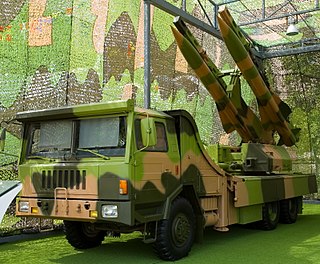
The KS-1 or Kaishan-1, military designation HQ-12 is the first Chinese surface-to-air missile to adopt a phased array radar.

Lakshya is an Indian remotely piloted high speed target drone system developed by the Aeronautical Development Establishment (ADE) of DRDO. A variant Lakshya-1 is used to perform discreet aerial reconnaissance of battlefield and target acquisition.

ALAS is a Serbian long-range multipurpose wire guided missile system developed by the private company EdePro and the state-owned Yugoimport SDPR. The ALAS missile system was developed primarily for missions against tanks, armored vehicles, fortifications, command posts, low-flying helicopters, coastal ships, industrial facilities and bridges. It can be deployed by any suitable platform including helicopters, armored vehicles, small ships and infantry. The guidance system is based on video/infrared technology, with the missile connected to the launcher by a fiber-optic cable. The ALAS flies at low altitude and has small radar and infrared (heat) signatures due to using a turbofan motor instead of a turbojet. In recent years, the ALAS platform has found a secondary use as a UAV.

The MQM-42 was a supersonic target drone developed by North American Aviation. Developed in two subvariants, Redhead and Roadrunner, it was used by the United States Army in the 1960s and 1970s.
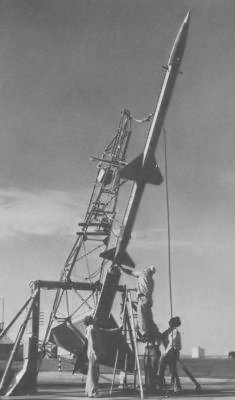
Boeing's Ground-to-Air Pilotless Aircraft (GAPA) was a short-range anti-aircraft missile (SAM) developed in the late 1940s by the US Army Air Force, and then the US Air Force after 1948. It was given the reference number SAM-A-1, the first Surface-to-Air Missile (SAM) in the 1947 tri-service designation system. By 1950 over 100 test rockets had been launched using a variety of configurations and power plants, with one launch in 1949 setting the altitude record for a ramjet powered vehicle at 59,000 ft (18,000 m).

The Denel Dynamics Skua is a turbojet-engined target drone used to simulate fast-moving attack aircraft during surface-to-air and air-to-air training exercises and weapons tests. It is manufactured by the Denel Dynamics division of the South African state-owned Denel aerospace and defence conglomerate.

The Composite Engineering BQM-167 Skeeter is a subscale aerial target (drone) developed and manufactured by Composite Engineering Inc. and operated by the United States Air Force and certain international customer air forces. It replaced the Beechcraft MQM-107 Streaker.

The Raytheon Coyote is a small, expendable, unmanned aircraft system built by the Raytheon Company, with the capability of operating in autonomous swarms. It is launched from a sonobuoy canister with the wings deploying in early flight phase.

















